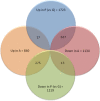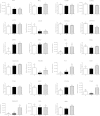Changes in granulosa cells gene expression associated with growth, plateau and atretic phases in medium bovine follicles
- PMID: 24955130
- PMCID: PMC4046060
- DOI: 10.1186/1757-2215-7-50
Changes in granulosa cells gene expression associated with growth, plateau and atretic phases in medium bovine follicles
Abstract
Background: The objective of this study was to build the transcriptomic profile of granulosa cells originating from follicles 6 to 9 mm in diameter in dairy cattle using microarrays.
Methods: Granulosa cells originating from three different phases of antral follicle growth were compared: growing (G), plateau (P) and atresia (A), as categorized by flow cytometry profiles of DNA. The growing and atretic conditions were each hybridized against the plateau condition as a reference in order to understand the specific biological mechanisms modulated in this class of follicles.
Results: 2,942 genes were differentially expressed (P < 0.05) in P vs. G and 1,974 in A vs. P. A clear segregation of the 3 phases was confirmed by between group analysis (BGA). The first characteristic of the plateau phase is the activation of the upstream regulators TP53 and PTEN which participate in the reduction of cell growth through MYC, FOS and E2F1-2-3. We also observed the down-regulation of steroidogenesis genes: CYP11A1 and CYP19A1, in the granulosa cells of the plateau phase relative to the growth phase. On the other hand, the A vs. P contrast showed up-regulation of multiple transcripts associated to apoptosis: CCT2, DAB2, DSG2 and TGM2.
Conclusions: This study offers multiple candidate genes to be further studied in order to elucidate their role in the modulation of follicular development and, ultimately, of oocyte quality.
Keywords: Cow; Granulosa cells; Growth status; Transcriptome.
Figures







Similar articles
-
Global gene expression in granulosa cells of growing, plateau and atretic dominant follicles in cattle.Reprod Biol Endocrinol. 2015 Mar 8;13:17. doi: 10.1186/s12958-015-0010-7. Reprod Biol Endocrinol. 2015. PMID: 25879740 Free PMC article.
-
Transcriptome profiling of granulosa cells from bovine ovarian follicles during atresia.BMC Genomics. 2014 Jan 18;15:40. doi: 10.1186/1471-2164-15-40. BMC Genomics. 2014. PMID: 24438529 Free PMC article.
-
Expression of mRNA for follistatin and inhibin/activin subunits during follicular growth and atresia.J Mol Endocrinol. 1994 Dec;13(3):253-64. doi: 10.1677/jme.0.0130253. J Mol Endocrinol. 1994. PMID: 7893343
-
Morphological classification of bovine ovarian follicles.Reproduction. 2010 Feb;139(2):309-18. doi: 10.1530/REP-09-0177. Epub 2009 Sep 28. Reproduction. 2010. PMID: 19786400 Review.
-
Follicular atresia in pigs: measurement and physiology.J Anim Sci. 1995 Sep;73(9):2834-44. doi: 10.2527/1995.7392834x. J Anim Sci. 1995. PMID: 8582874 Review.
Cited by
-
The genomic response of human granulosa cells (KGN) to melatonin and specific agonists/antagonists to the melatonin receptors.Sci Rep. 2022 Oct 20;12(1):17539. doi: 10.1038/s41598-022-21162-y. Sci Rep. 2022. PMID: 36266374 Free PMC article.
-
WGBS of embryonic gonads revealed that long non-coding RNAs in the MHM region might be involved in cell autonomous sex identity and female gonadal development in chickens.Epigenetics. 2024 Dec;19(1):2283657. doi: 10.1080/15592294.2023.2283657. Epub 2023 Dec 1. Epigenetics. 2024. PMID: 38037805 Free PMC article.
-
Developmental, cytogenetic and epigenetic consequences of removing complex proteins and adding melatonin during in vitro maturation of bovine oocytes.Front Endocrinol (Lausanne). 2023 Oct 23;14:1280847. doi: 10.3389/fendo.2023.1280847. eCollection 2023. Front Endocrinol (Lausanne). 2023. PMID: 38027209 Free PMC article.
-
Regulation of the transcription factor E2F1 mRNA in ovarian granulosa cells of cattle.J Anim Sci. 2020 Jan 1;98(1):skz376. doi: 10.1093/jas/skz376. J Anim Sci. 2020. PMID: 31832639 Free PMC article.
-
Cumulus cells surrounding oocytes with high developmental competence exhibit down-regulation of phosphoinositol 1,3 kinase/protein kinase B (PI3K/AKT) signalling genes involved in proliferation and survival.Hum Reprod. 2017 Dec 1;32(12):2474-2484. doi: 10.1093/humrep/dex320. Hum Reprod. 2017. PMID: 29087515 Free PMC article.
References
-
- Erickson BH. Development and senescence of the postnatal bovine ovary. J Anim Sci. 1966;25(3):800–805. - PubMed
Publication types
MeSH terms
LinkOut - more resources
Full Text Sources
Other Literature Sources
Molecular Biology Databases
Research Materials
Miscellaneous

